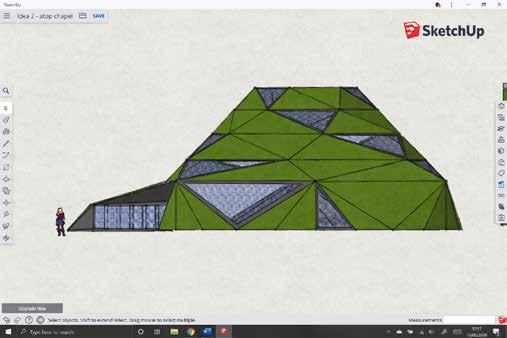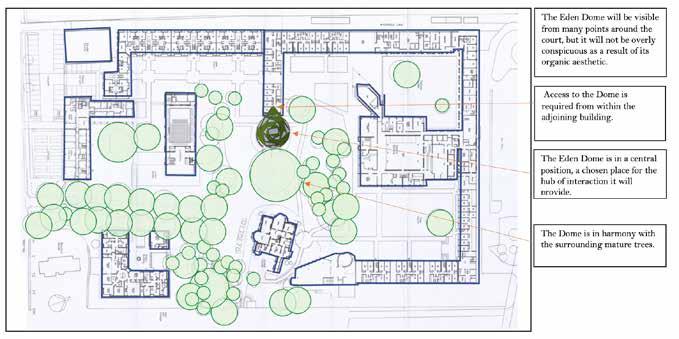
3 minute read
43 The Eden Dome Tim Emmens
from Ink 2020/21
This was submitted to a competition run by Fitzwilliam College, Cambridge
Tim Emmens Lower Sixth
As a centre for students and fellows to collaborate, this will be a busy space, and thus the noise levels may be high. To reduce reverberation, the panels on the ceiling will be clad in a dampening material. Different spaces in the dome are divided to further reduce unwanted noise: the study rooms are sectioned, and the lounge and study ‘bars’ are sectioned off by way of the aforementioned hanging sound barriers. These different modules cater for all different scales of collaborative work, from one-to-one discussions on the mezzanine floor, to group work on the large desks in the centre.
Design brief:
Design Challenge Brief: You are challenged to design a new building somewhere on the Fitzwilliam College site. This building will serve as a hub for interaction between teaching Fellows and students, where they can share and explore ideas.
Design Narrative:
My initial decision to build this ‘hub of interaction’ on top of the chapel resulted from observing the available space and deciding that the carefully considered landscaping should be preserved. My idea is to ‘crown’ the chapel. Many a cathedral has a magnificent dome and I believe the architecture of Sir Richard MacCormac deserves its own. Despite this grandiose metaphor, this design should simultaneously blend into the green spaces of the college. With an extensive sedum roof, this would maintain the natural, green aesthetic of the college courts and help fulfil environmentally conscious criteria. My inspiration for the angular, spiral design came from a combination of partly Fibonacci’s sequence - strongly featured in nature and specifically represented in spiralled sunflower seeds; and partly the angular, copper-roofed buildings surrounding the Central Building. The triangular windows allow good levels A small kitchen area is essential to keep of light throughout the day. Within the students and fellows hydrated and ‘fuelled’ dome, the acoustic barriers are wooden in their studies and encourage ‘watercooler slats with a foam cladding - preserving moments’ - as unplanned interactions the light levels as much as possible between a variety of different groups of whilst dampening sound. The large panel students and fellows is key to the space’s windows on either side of the stair well intention. provide additional light. I wanted to sustain this In retrospect, there are light throughout the some aspects of the dome, so the study rooms design that could be have Jalousie windows, developed. To maintain enabling light and privacy the light coming into the concurrently. chapel, the dome could have a smaller diameter, Air is key to a productive or vertical, rather than hive of collaboration, so I have included angled edges, retaining light coming indoor plants with a high oxygen output through the chapel’s ceiling windows. (e.g. Areca Palm, Snake Plant) to maintain a high air quality. The flow of air is also These designs are based on the assumption important, so the skylight windows will that access to the dome can be constructed be remotely openable, and this will also from the adjoining building. counteract a potential heating effect in the dome.
The triangular windows allow good levels of light throughout the day.
There are three main aspects of architectural design I believe are paramount to a successful built space and a productive environment: light, sound and air quality. I have addressed each of these aspects with care in my design.
















